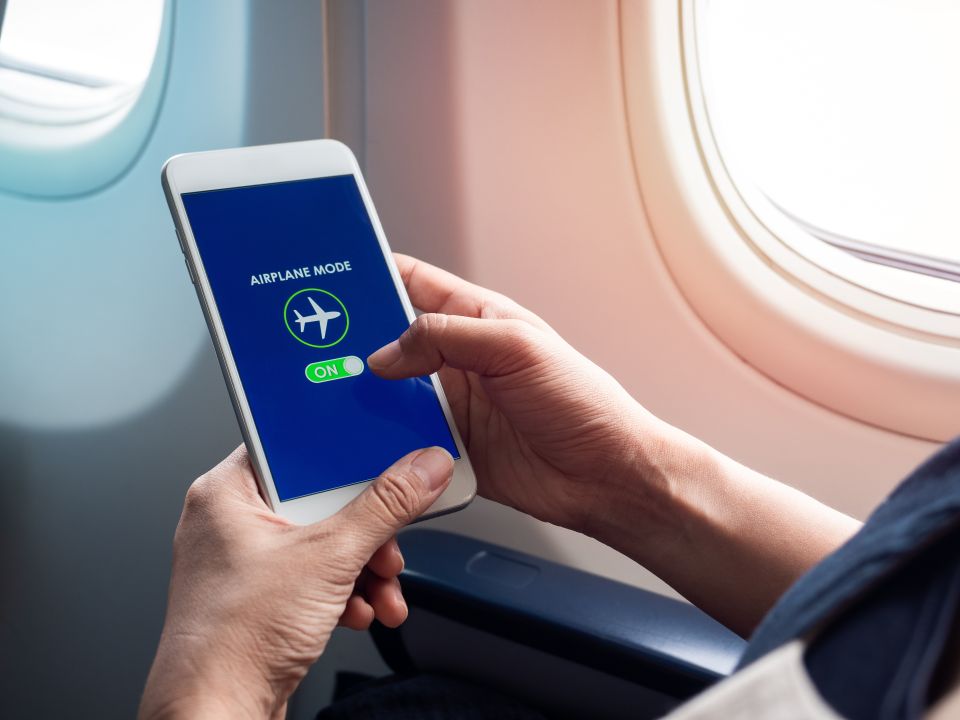Although technology has come a long way in 60 years, we still can’t use the phone
We all know the string by heart: “Please make sure your seats are upright, trays down, blinds up, laptops stowed in overhead bins, and electronics in airplane mode.”
Obviously the first four are reasonable, right? The blinds have to be up so we can see if there’s an emergency, like a fire. The retractable tables must be folded and the seats in an upright position so that we can quickly get out of the seat in case of need. Laptops could become projectiles in an emergency, as pockets in seat backs aren’t strong enough to contain them.
As for cell phones, they have to be in airplane mode so they can’t cause interference with in-flight devices, right? Well, it all depends on who we ask.
Technology has come a long way
Air navigation and its communications are based on radio systems, which since the 1920s have been optimized to minimize interference. As for the digital technology that is used today, it is much more advanced than the old analog technologies that were used up to 60 years ago.
Research has shown that personal electronic devices can emit signals within the same frequency band as aircraft communication and navigation systems, creating what is known as electromagnetic interference.
But in 1992, the US Federal Aviation Authority and Boeing, in an independent study, investigated whether the use of electronic devices caused interference on airplanes and found no problems with computers or other personal electronic devices during the off-phases. critical phases of the flight (takeoffs and landings are considered critical phases).
The US Federal Communications Commission decided to create separate frequencies for different uses – mobile telephony, navigation and aircraft communications – so that they do not interfere with each other. Governments around the world developed the same strategies and policies to prevent interference. In the European Union, activated electronic devices have been allowed since 2014.
2.2 billion passengers
So, with these global regulations in place, why has the aviation industry continued to ban the use of mobile phones? One of the problems lies in something that may not be expected: terrestrial interference.
Wireless networks are connected by a series of towers that could become overloaded if passengers flying over these networks use their phones at the same time. The number of passengers who flew in 2021 was more than 2.2 billion (half the number of passengers in 2019).
On the other hand, in recent years a new wireless communication standard has been adopted. Current 5G networks – desirable for their higher data transfer speeds – have caused concern in the aviation industry.
The bandwidth of the radio frequencies is limited, however, attempts are still being made to add more devices. The aviation industry notes that the 5G wireless network bandwidth spectrum is remarkably close to the bandwidth spectrum reserved for aviation, which could cause interference with navigation systems that help aircraft land.
Airport operators in Australia and the United States have raised concerns about aviation safety in relation to the 5G rollout, although it appears that the European Union has rolled out smoothly. In any case, it seems prudent to limit mobile phone use on planes while 5G-related issues are cleared up.
Ultimately, we cannot forget the aggressiveness
Today, most airlines offer free or paid Wi-Fi services to their customers. With new Wi-Fi technologies, passengers could, in theory, use their mobile phones to make video calls with friends or clients during the flight.
On a recent trip, I spoke with a flight attendant and asked her opinion on using the phone during flights. She stated that it would be inconvenient for cabin crew to have to wait for passengers to finish their calls to ask if they would like any drinks or food. On a plane with more than 200 passengers, onboard service would take much longer to complete if everyone is on the phone.
For me, the issue of in-flight phone use has more to do with the social experience of having 200+ people on a plane talking at once. In an age where disruptive passenger behavior, including aggressiveness, is becoming more prevalent, in-flight phone use could be another trigger that completely changes the flight experience.
Disruptive behavior takes many forms, from failure to comply with safety requirements, such as not wearing a seat belt, to verbal altercations with fellow passengers and cabin crew, to physical altercations with passengers and crew cabin, which are usually identified as air rage (air aggressiveness).
In conclusion, the use of phones during the flight does not currently affect the operation of the aircraft. But cabin crews prefer not to delay in providing in-flight services to all passengers: there are many people to attend to.
However, 5G technology is affecting the radio bandwidth of aircraft navigation systems; we need more research to understand how 5G interferes with aircraft navigation during landings. Let’s remember that when we talk about the two most critical phases of flight, takeoffs are optional, but landings are mandatory.
*Doug Drury is Professor and Head of Aviation at CQ University in Australia.

